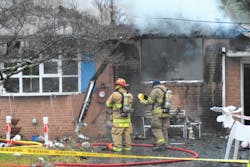Chief Concerns: The Birth of Adopt-a-Neighborhood
Christmas Eve 2014, like most other, was full of last-minute shoppers and families traveling from point A to point B and everywhere in between. Shortly after 8 a.m., units were dispatched to a reported house fire in the non-hydrant community of Sherwood Manor, outside the Beltway on the eastern edge of Prince George's County. Fire/EMS units from the Prince George’s County Fire/EMS Department (PGFD) and Anne Arundel County arrived to find a single-story rambler-style home with fire showing.
Firefighters were met by an adult female occupant who gave information about an elderly male who was trapped in the home. (Neighbors had helped the adult female escape through a window prior to the fire department’s arrival.) Firefighters immediately initiated a search and quickly found the victim. He was removed to awaiting EMS units, which initiated advanced life support procedures and transported the gravely injured occupant. The victim later succumbed to his injuries.
While the death is horrific, what’s worse is that fire investigators found NO working smoke alarm in the 60-plus-year-old home. They determined that the fire originated in a family room area, where combustibles were left too close to a portable heater.
Our communities rightfully expect that the fire/EMS department will keep them safe. While the death is not the fire department’s “fault,” as fire chief, I take every fire fatality personally. Fires and fire fatalities become doubly personal when they occur during the festive holiday season. Although many disagree, fire fatalities can be termed as a failure in a fire department’s overall community risk reduction (CRR) efforts. Recognizing that firefighting is an inherently dangerous business, we should be striving for ZERO fire fatalities, both with the public we serve and within our own ranks.
Less than 24 hours after the first incident, on Christmas Day, PGFD units were dispatched to a house fire in the Seat Pleasant community, inside the Beltway near the border with Washington D.C. First-in units found a two-story duplex with fire showing from three sides. The significantly advanced fire would ultimately claim the life of an elderly female. A working smoke alarm DID notify the residents. An adult male was able to escape and attempted to pull his mother out of the upper window. Unfortunately, she slipped from his and neighbor’s grasp and was unable to get out.
Making changes
These two incidents represented the fourth and fifth fire fatalities for Prince George’s County in 2014. While these fatalities are extremely unfortunate, it is important to note that the total for the year—five—was a significant reduction over the annual average of nine. Our fire prevention and protection legislation is second to none. Residential smoke alarms have been required in all homes since 1987, and fire sprinklers required in all new residential construction since 1992. Carbon monoxide (CO) requirements were added in 2014 for all homes with gas service, fireplaces or attached garages.
But all of those great codes and efforts didn't help victims four and five one bit. As we have done for many years after fatal fires, PGFD firefighters flooded those neighborhoods, knocking on doors, checking and installing smoke alarms and providing safety information—this time the day after Christmas. Yes, this program—named the Post-Incident Neighborhood Intervention Program (PINIP)—is indeed a completely reactive response geared to capitalize on the community’s heightened awareness and concern immediately following significant incidents.
At the scene of both incidents the day after, I interacted with two different community leaders who asked the simple and usually trite question, “What can we do to help?” It came first from the president of the International Association of Fire Fighters Local 1619, then from the victim’s pastor. That “trite” question was the birth of the Adopt-A-Neighborhood program.
With further discussion, the firefighter/paramedic union and the church agreed to donate smoke alarms, CO detectors, and cash to help PGFD canvass those neighborhoods.Additionally, both agreed to provide meeting space for those communities to come together for proactive fire prevention and public education meetings.
Going tech
The Adopt-A-Neighborhood program has slowly matured as a proactive program, with eight businesses and churches donating nearly $30,000 to help cover multiple areas around the county. Materials/funds are donated to the 501(c)(3) Fire Chiefs Community Advisory Council, which then provides alarms, detectors and literature to the PGFD for delivery and installation.
To effectively track neighborhood saturation efforts, a Collector app on the ArcGIS platform, using county GIS mapping data, was developed by the county’s Office of Information Technology. Layers within the app allow for instantaneous tracking and data collection in an Internet-based environment, using individual smartphones. Data tracks the address, status of the visit, service provided and other information. Never before have we been able to immediately track progress and successes of this portion of our CRR programs. We continue to identify layers and options to improve the program functionality. Both paid and volunteer firefighters can now get the app on their phones, and are able to immediately track smoke alarm and CO detector installations 24 hours a day, year round.
In conjunction with the county's 3-1-1 capacity to capture routine “smoke alarm requests,” the Collector app places PGFD’s ability to qualify and quantify the CRR program statistical efforts in a new and more effective place. The program is a little less than one year old; however, successful smoke alarm alert stories continue to roll in. I’ll take those success stories everyday over another senseless death in an unprotected home.
In sum
We should all look forward to the time when we’re not talking about residential fire fatalities. Smoke alarms, CO detectors and residential sprinklers DO make a difference. As we will do in Prince George’s County, I urge you to continue doing everything you can in your communities to spread the message of safety. We will do our part to make sure everyone goes home, including our residents.

Marc S. Bashoor
MARC S. BASHOOR joined the fire service in 1981. In 2017, he retired as fire chief of Prince George’s County, MD, Fire/EMS, the largest combination department in North America. His progressive community-based approach led to record hiring and a strategic apparatus replacement plan.
Twitter: @ChiefBashoor
Email: [email protected]






